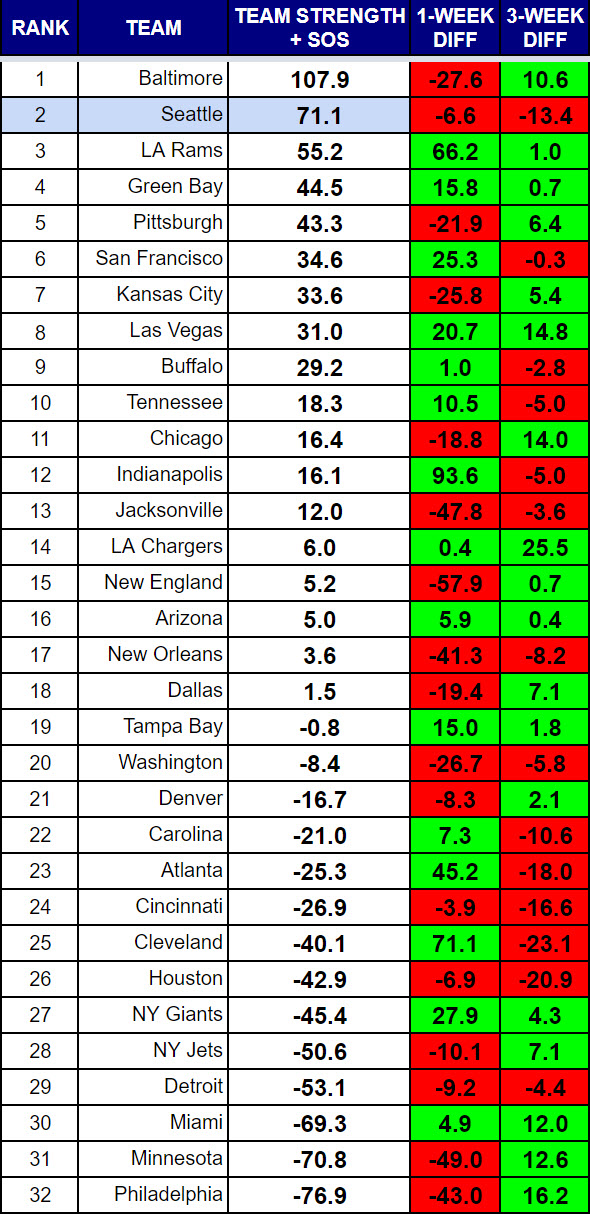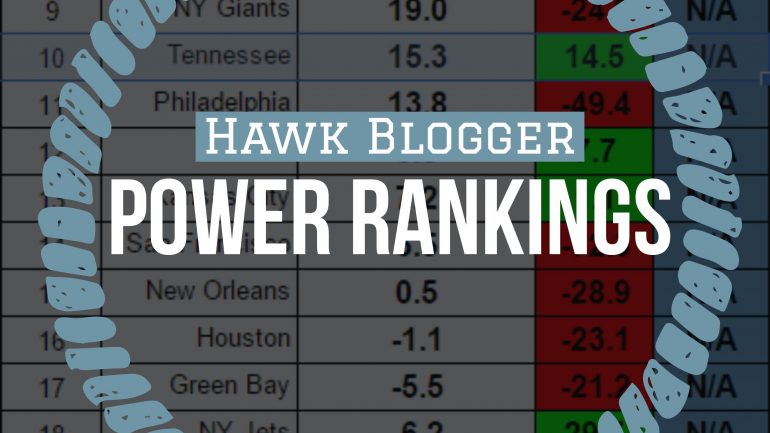Seattle and Baltimore retain the top two spots in the rankings after each team won again. The Ravens are significantly ahead of the Seahawks in team strength due to a far superior defense, and would be even further ahead if their strength of schedule wasn’t so much weaker. Baltimore has faced the 21st-ranked schedule thus far to Seattle’s 11th-ranked schedule.
The Bills and Bears rank 32nd and 31st, respectively in SOS. Tennessee and Pittsburgh rank 29th and 28th. The Packers rank 26th and the Cardinals rank 22nd. Those are all undefeated teams who may not have truly been tested yet.
Speaking of the bottom, I can’t say I’ve ever seen Philadelphia as the 32nd-ranked team in my rankings. That they are 0-2 and have a weak SOS does not bode well for that team, and knowing that city, the coaching staff may be at risk. Once considered a tougher part of the Seahawks schedule, they may softening.
Another shocker is the Vikings at thirty-one. Their offense, especially passing, has been dreadful. They are really missing Stefon Diggs. Meanwhile, their powerhouse defense has been giving up over 35 points per game and a mind-blowing 116.7 passer rating.
The Vikings and Eagles demise means the Seahawks will now play the bottom three teams in these rankings, and five of the bottom six.
They will need to improve a defense that is performing below all but two teams in the top tend. Green Bay and Las Vegas slide in under Seattle. The Packers are giving up a 102.9 passer rating, over 5 yards per run, and 27.5 points per game. Seattle matches that putrid points per game, but at least is near the top of the league in stopping the run.
The Rams are worthy of attention, and may be the Seahawks biggest competition within a very tough division. All four NFC West teams rank in the top half of the league, and three of them rank in the top six.
All four NFC West teams rank in the top half of the league, and three of them rank in the top six.
Is is surprising to see the Cardinals so far down the list after beating a good 49ers team in week one. They would jump a couple spots if you removed the SOS modifier, but what is holding them back is low passer rating on offense (83.1) and a high opponent passer rating (95.6). A negative passer rating differential does not usually work out well over time.

Rankings Visualization
This view shows tiers of strength that develop over the course of the season.

RANKINGS EXPLAINED
Power rankings are always debatable. I don’t buy into the gut feel methods most places use to determine their rankings, so I developed a formula a few years back that attempts to take at least some of the subjectivity out of the discussion. My approach was simple, I measured offensive and defensive efficiency based on the Yards Per Carry (YPC) and Yards Per Attempt (YPA), as well as points scored and points allowed. The formula to calculate “Team Strength” was as follows:
(YPC (offense) + YPA (offense) + Avg Pts/Game Scored) – (YPC (defense) + YPA (defense)+ Avg Pts/Game Allowed)
The formula has proven to be a pretty accurate predictor of success (roughly 70% of the teams ranked in the Top 10 by week 3 make the playoffs), but I am always looking for ways to improve it. I read a great article on ColdHardFootballFacts.com. There was one gem in there about predicting championship teams. The article mentioned passer rating differential as the “mother of all stats.” A full 69 of 72 champions have ranked in the Top 10 in this statistic. It is a stat after my own heart, as I believe offensive and defensive efficiency is the key measurable outside of point differential. Turnovers would factor in there as well, but I am not convinced a team has as much control over that. My power rankings use YPA and YPC differentials. I went ahead and replaced the YPA with offensive and defensive passer rating, to give me this:
(YPC (offense) + Passer Rating (offense) + Avg Pts/Game Scored) – (OPP YPC (defense) + OPP Passer Rating (defense)+ OPP Avg Pts/Game) As of September 23, 2014, I have added a strength of schedule component to the rankings as well. As of November 22, 2016, I have increased the weighting of the run game and point differential. Yards per carry will be multiplied by 10 to make it more evenly weighted with the passer rating. It is still roughly half as important, but will have a greater impact. Point differential will be multiplied by two as it still should be among the most important aspects of measuring teams.
